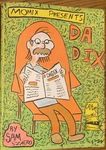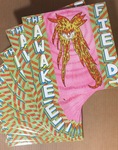
retail price - $10.00
copacetic price $9.25
Conspiracy Comics #1
published by Self-published
Here’s another timely release by Pittsburgh comics making powerhouse, Jim Rugg. Conspiracy Comics is a full color comic book in the classic mode – printed on heavy paper stock and with glossy cardstock covers – that presents three wildly disparate tales that are nevertheless united in their focus on subjectivity and mirroring.
In the first, a ten-pager set right here in Pittsburgh, we delve into the the mystery of “The Ghost Bomber of the Monongahela.” On January 31, 1956, a B-25 bomber crash-landed into the Monongahela River, right smack in the middle of the American steel industry, between the Homestead Works and the Southside Works on one side and the Edgar Thompson Works and the Hazelwood Works on the other. There, the bomber slowly sank – likely within a mile or less from where the steel from which it was assembled was, at least in part, cast, forged, rolled and/or stamped, while thousands more tons of steel were continued being churned out all around it in what were still the glory days of the Steel City. While the records of steel production and airplane manufacturing are all clearly and precisely recorded, what happened to that particular B-25 bomber in the hours and days after it crash-landed remains shrouded in a mystery that may or may not have been deliberately constructed to hide, or at least obfuscate, the truth. Rugg’s comic deftly illustrates how, when the objective facts remain unknown – or are activvely hidden – subjective opinions have a tendency to take their place and speculation runs wild, and conspiracy theories are born!The last is another ten-pager. “The War on Drugs” is told in the classic True Crime mode forged by Charles Biro & Co. in comics like Crime Does Not Pay. Here we have another chapter in the self-penned saga of the aptly named George Hunter White, a story where subjectivity runs amok as we get a wholly one-sided, no-corroboration-necessary-here-folks account set in the 1930s, at the dawn of the (still ongoing) War on Drugs led by Harry Anslinger’s Bureau of Narcotics. The perspective criminalizing drugs laid out during these early years remain in the air to this day, propagated through the numerous outlets to the public imagination channeled by the varied forms of pulp fiction. Rugg’s treatment of the material demonstrates that true crime comics are not altogether distinct, as a genre, from superhero comics and that both can be seen as falling under a more general category of heroic fantasy, along with others such the western, sword and sorcery, and war.
Dividing these two ten-page tales is the blockbuster four-pager, “Christmas Cage March!” a tale from the world of professional wrestling, where nothing is what it seems, and which could – with thinking cap firmly in place – be taken to be a masterclass lesson in the logic of conspiracy theory thinking. Collusion, contrivance, pre-determined outcomes, spectacular violence – the world of professoinal wrestling can stand as a syndecdoche for the Society of Spectacle in which we dwell.
And that's a wrap on the the first issue! Will there be a second? What do you think?
BACK IN STOCK! Limited quantity. All copies signed on front cover!
This item belongs to the categories:
History & Biography, Made in Pittsburgh, standard pamphlet comic book
You may also enjoy these related titles:
Search Copacetic
Just in:





















